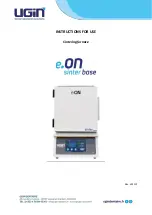
SERVICING
46
S-314 CHECKING FLAME SENSOR
A flame sensing device is used in conjunction with the ignition
control module to prove combustion. If proof of flame is not
present the control will de-energize the gas valve and “retry”
for ignition or lockout.
WARNING
H
IG
H
V
O
L
T
AGE
D
ISC
O
NNEC
T
ALL
P
O
WER
B
E
FO
RE SERVICING
O
R
INS
T
ALLING
TH
IS
U
NI
T.
M
U
L
T
IPLE P
O
WER S
OU
RCES MA
Y
B
E PRESEN
T.
F
AIL
U
RE
TO
D
O
S
O
MA
Y
CA
U
SE PR
O
PER
TY
DAMAGE
,
PERS
O
NAL INJ
U
R
Y
O
R DEA
TH.
1. Connect a micro-amp meter in series with this wire and
the sensor terminal.
2. Be sure the positive side of the meter is to the sensor
(depending on the model) and the negative side of the
meter is to sensor terminal.
L
INE V
O
L
T
AGE N
O
W PRESEN
T
WARNING
3. Place the unit into a heating cycle.
4. As soon as flame is established a micro-amp reading
should be evident once proof of flame (micro-amp reading)
is established, the hot surface ignitor will be de-energized.
5. The Integrated Ignition controls will have 1 to 4 micro-
amps. If the micro-amp reading is less than the minimum
specified, check for high resistance wiring connections,
sensor to burner gap, dirty flame sensor, or poor
grounding.
6. If absolutely no reading, check for continuity on all
components and if good - replace ignition control module.
NOTE:
Contaminated fuel or combustion air can create a
nearly invisible coating on the flame sensor. This coating
works as an insulator causing a loss in the flame sense signal.
If this situation occurs the flame sensor must be cleaned with
steel wool.
WARNING
H
IG
H
V
O
L
T
AGE
D
ISC
O
NNEC
T
ALL
P
O
WER
B
E
FO
RE SERVICING
O
R
INS
T
ALLING
TH
IS
U
NI
T.
M
U
L
T
IPLE P
O
WER S
OU
RCES MA
Y
B
E PRESEN
T.
F
AIL
U
RE
TO
D
O
S
O
MA
Y
CA
U
SE PR
O
PER
TY
DAMAGE
,
PERS
O
NAL INJ
U
R
Y
O
R DEA
TH.
I
F
YOU
M
U
S
T
H
ANDLE
TH
E I
T
NI
TO
R
,
H
ANDLE WI
TH
CARE
.
T
OU
C
H
ING
TH
E IGNI
TO
R
BO
D
Y
WI
TH
B
ARE
F
INGERS
,
R
OU
G
H
H
ANDLING
,
O
R
VI
B
RA
T
I
O
N C
OU
LD RES
U
L
T
IN EARL
Y
IGNI
TO
R
F
AIL
U
RE
.
O
NL
Y
A
Q
U
ALI
F
IED SERVICER S
HOU
LD EVER
H
ANDLE
TH
E IGNI
TO
R
.
CAUTION
ANNUAL INSPECTION
The furnace should be inspected by a qualified installer, or
service agency at least once per year. This check should be
performed at the beginning of the heating season. This will
ensure that all furnace components are in proper working
order and that the heating system functions appropriately. Pay
particular attention to the following items. Repair or service
as necessary.
•
• Flue pipe system. Check for blockage and/or leakage.
Check the outside termination and the connections at
and internal to the furnace.
•
• Combustion air intake pipe system (where applicable).
Check for blockage and/or leakage. Check the outside
termination and the connection at the furnace.
•
• Heat exchanger. Check for corrosion and/or buildup
within the heat exchanger passageways.
•
• Burners. Check for proper ignition, burner flame, and
flame sense.
•
• Drainage system. Check for blockage and/or leakage.
Check hose connections at and internal to furnace.
•
• Wiring. Check electrical connections for tightness and/
or corrosion. Check wires for damage.
•
• Filters.
AIR FILTER
N
EVER
O
PERA
T
E
FU
RNACE WI
HTOUT
A
F
IL
T
ER INS
T
ALLED AS D
U
S
T
AND LIN
T
WILL
BU
ILD
U
P
O
N IN
T
ERNAL PAR
T
S RES
U
L
T
ING IN L
O
SS
OF
E
FF
ICIENC
Y,
EQ
U
IPMEN
T
DAMAMGE
,
AND P
O
SSI
B
LE
F
IRE
.
WARNING
Filters must be used with this furnace. Filters do not ship
with these furnaces but must be provided by the installer for
proper furnace operation.
Remember that dirty filters are the most common cause of
inadequate heating or cooling performance.











































